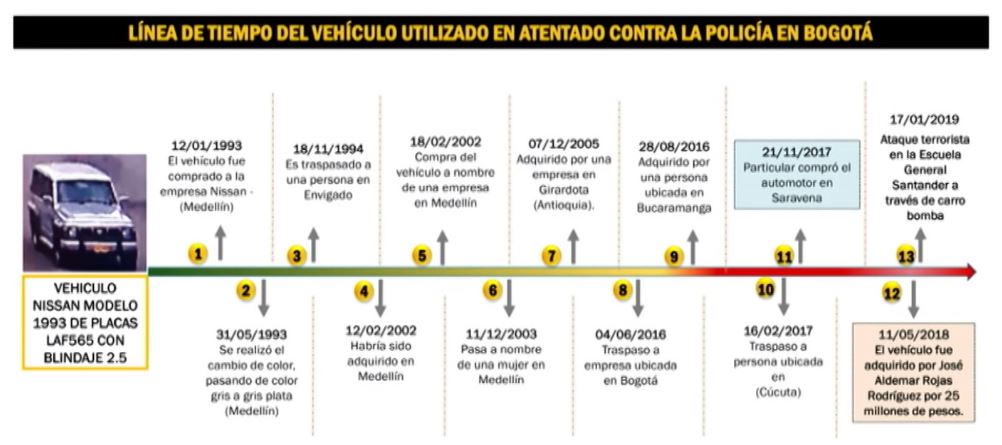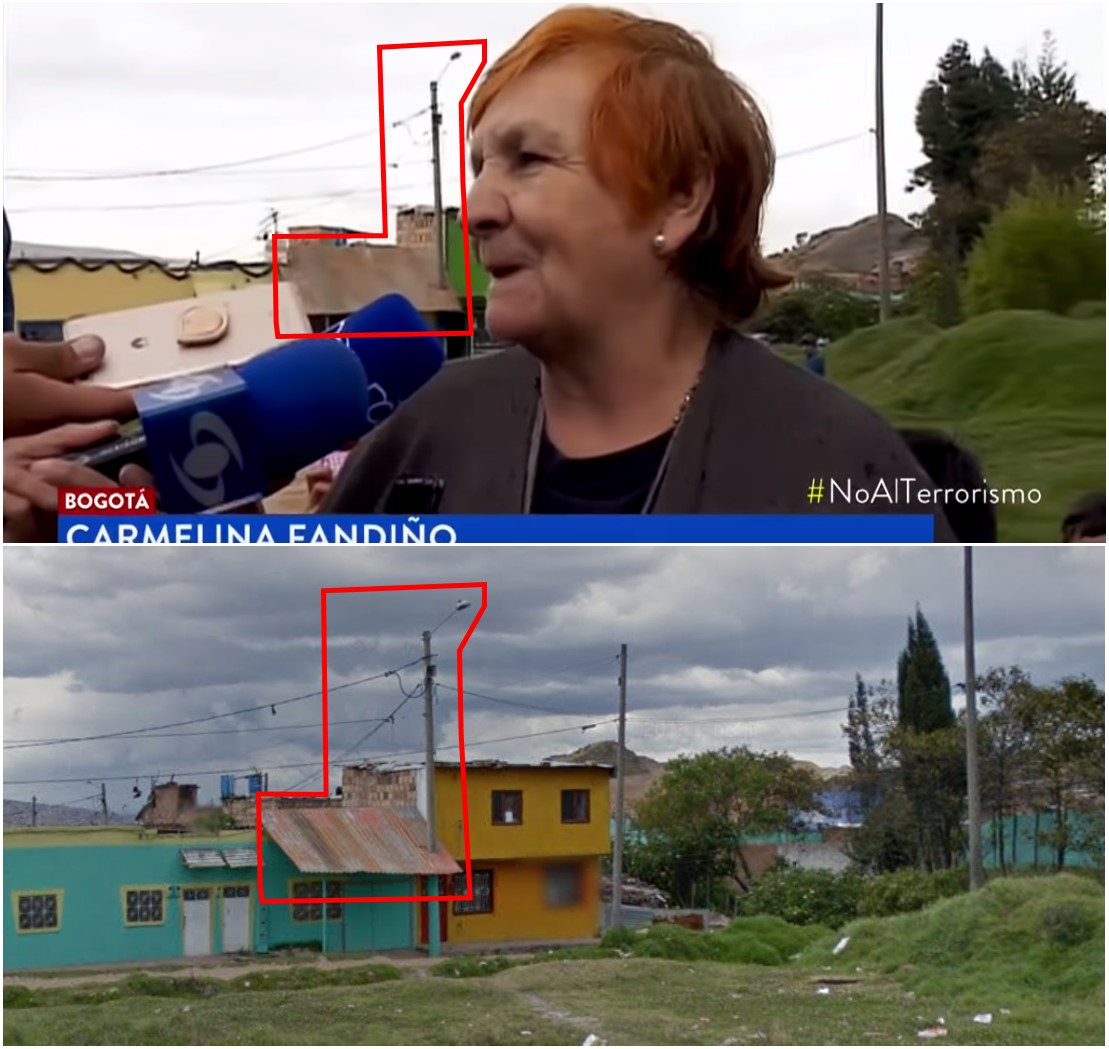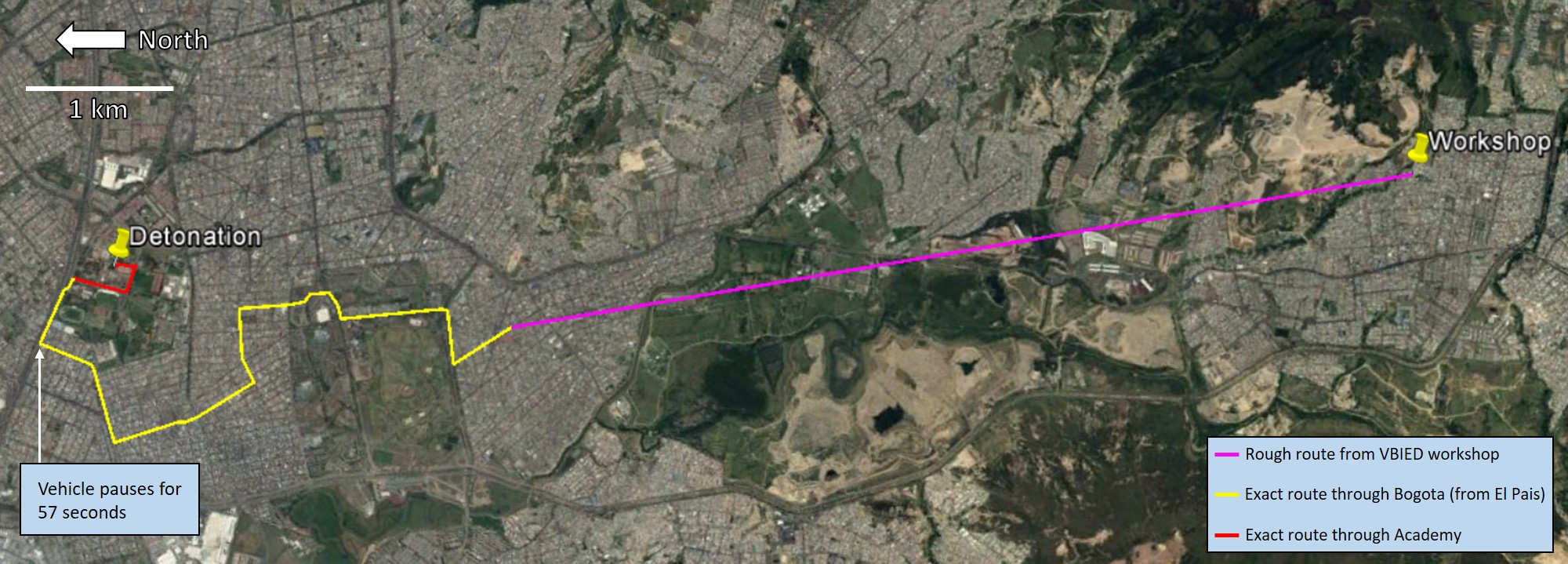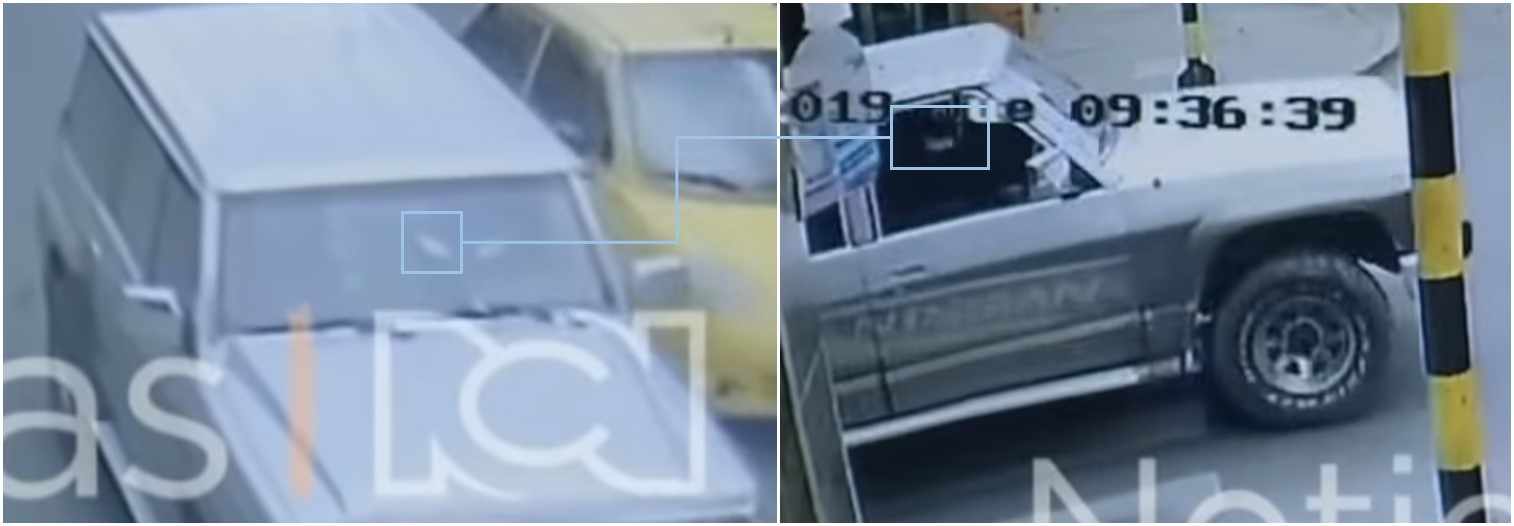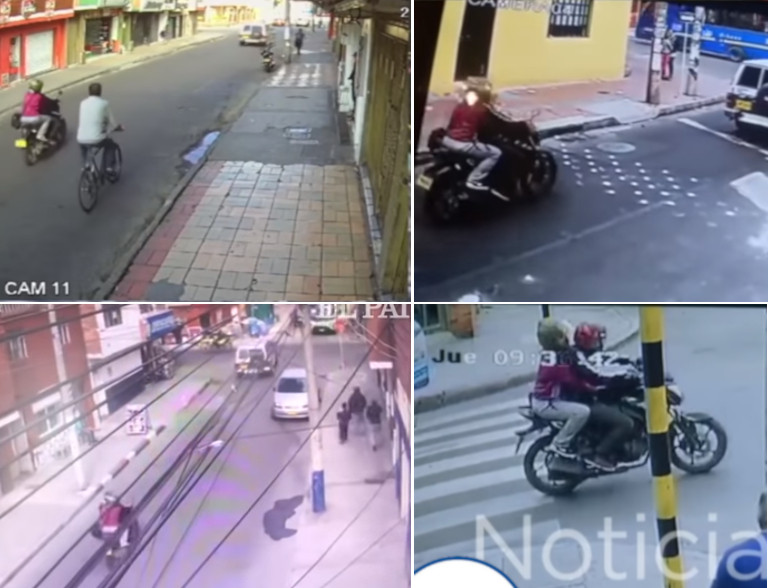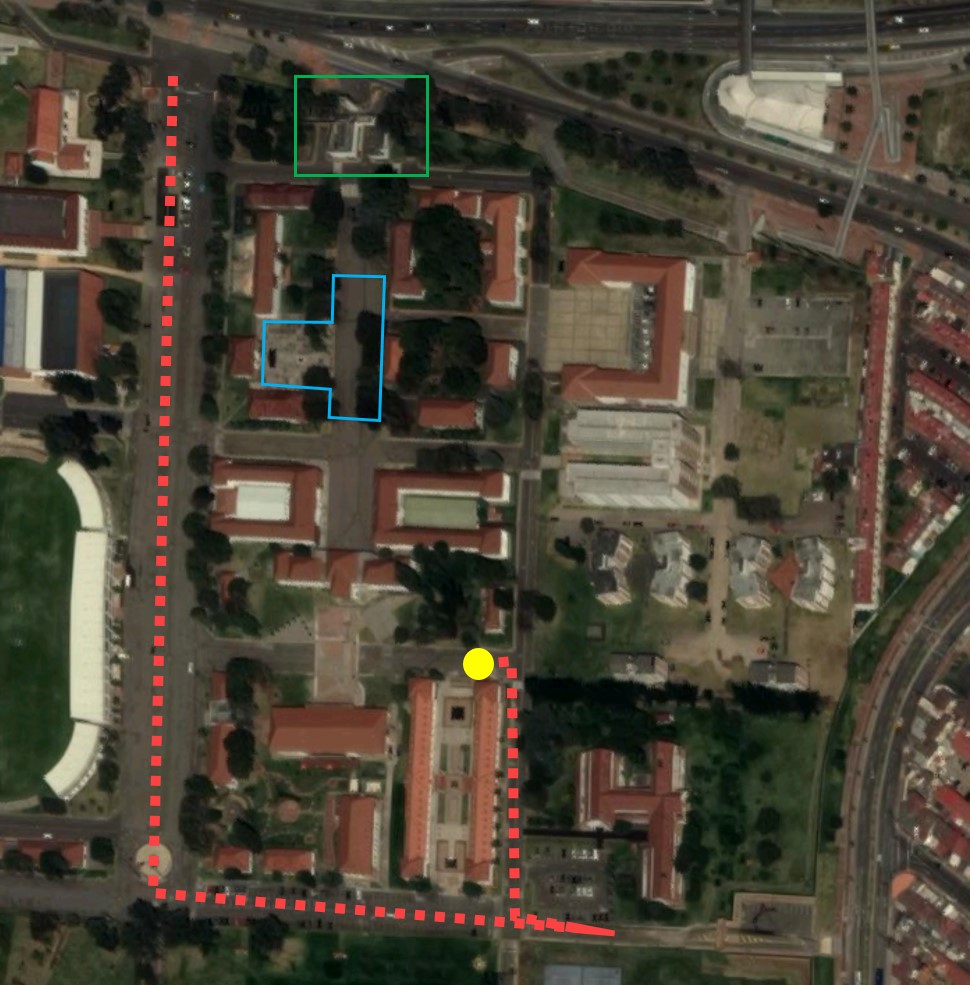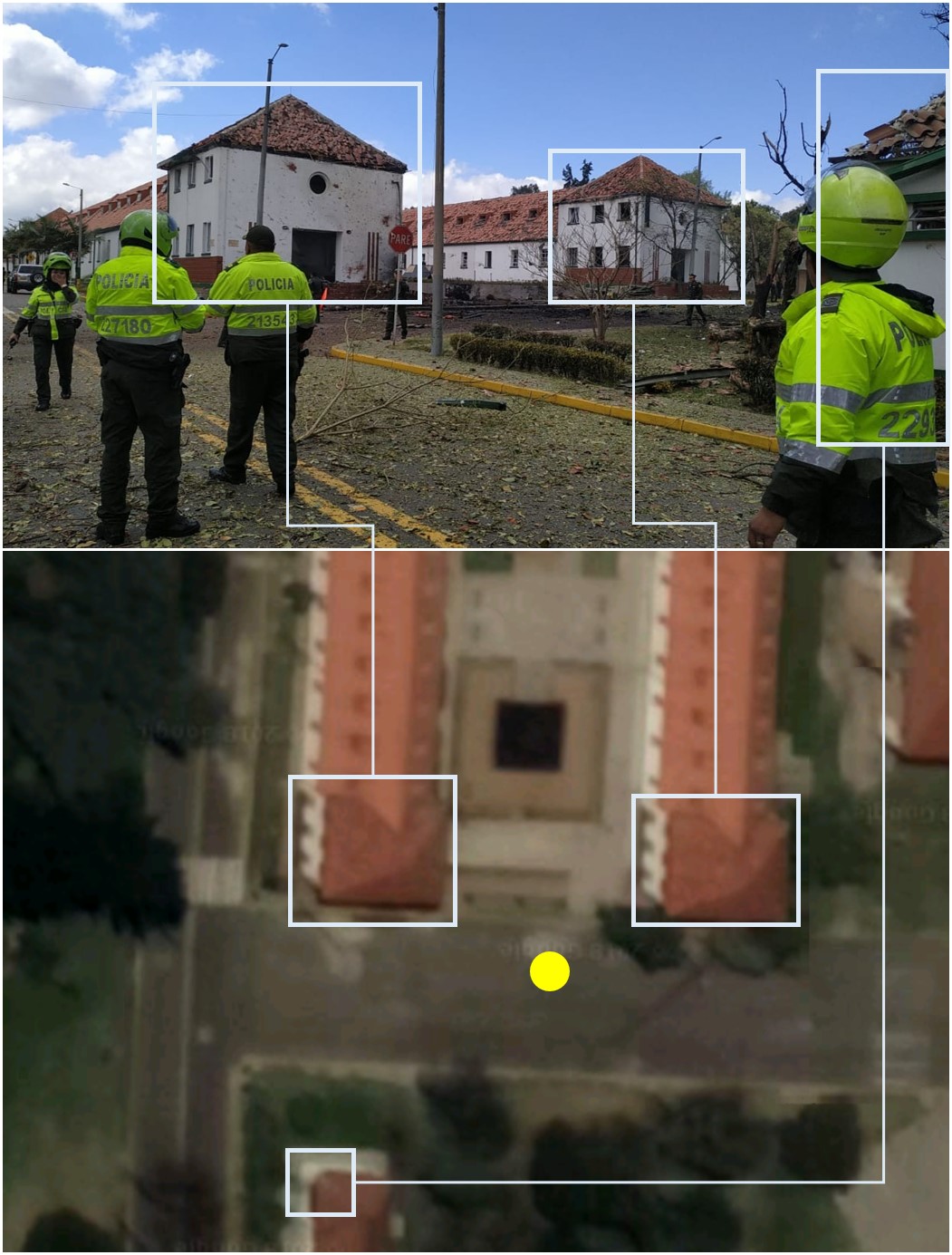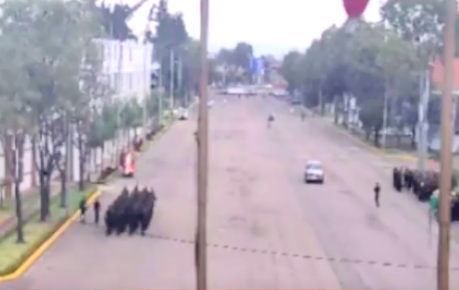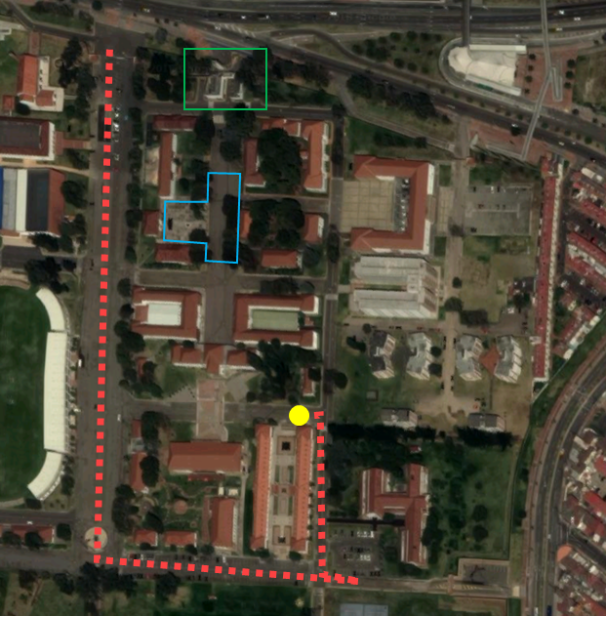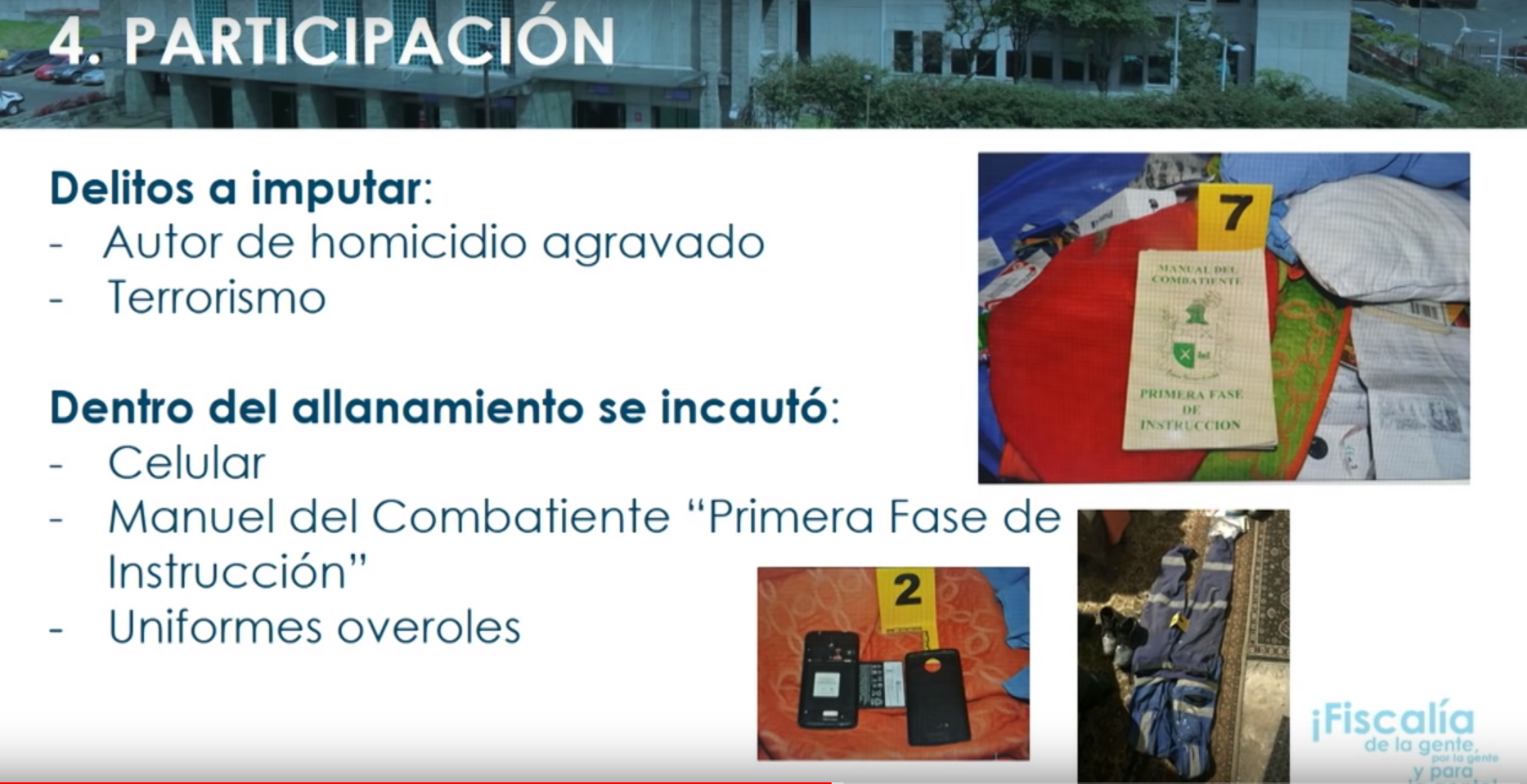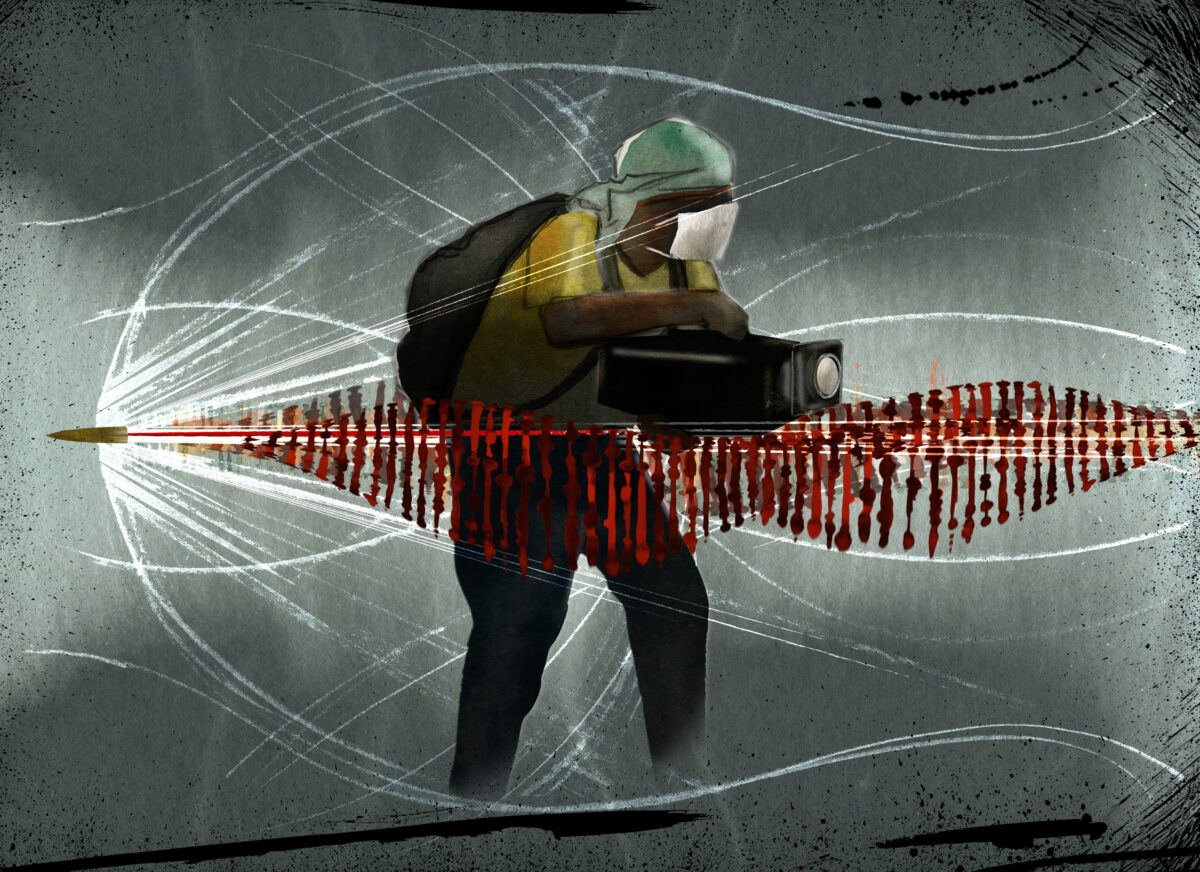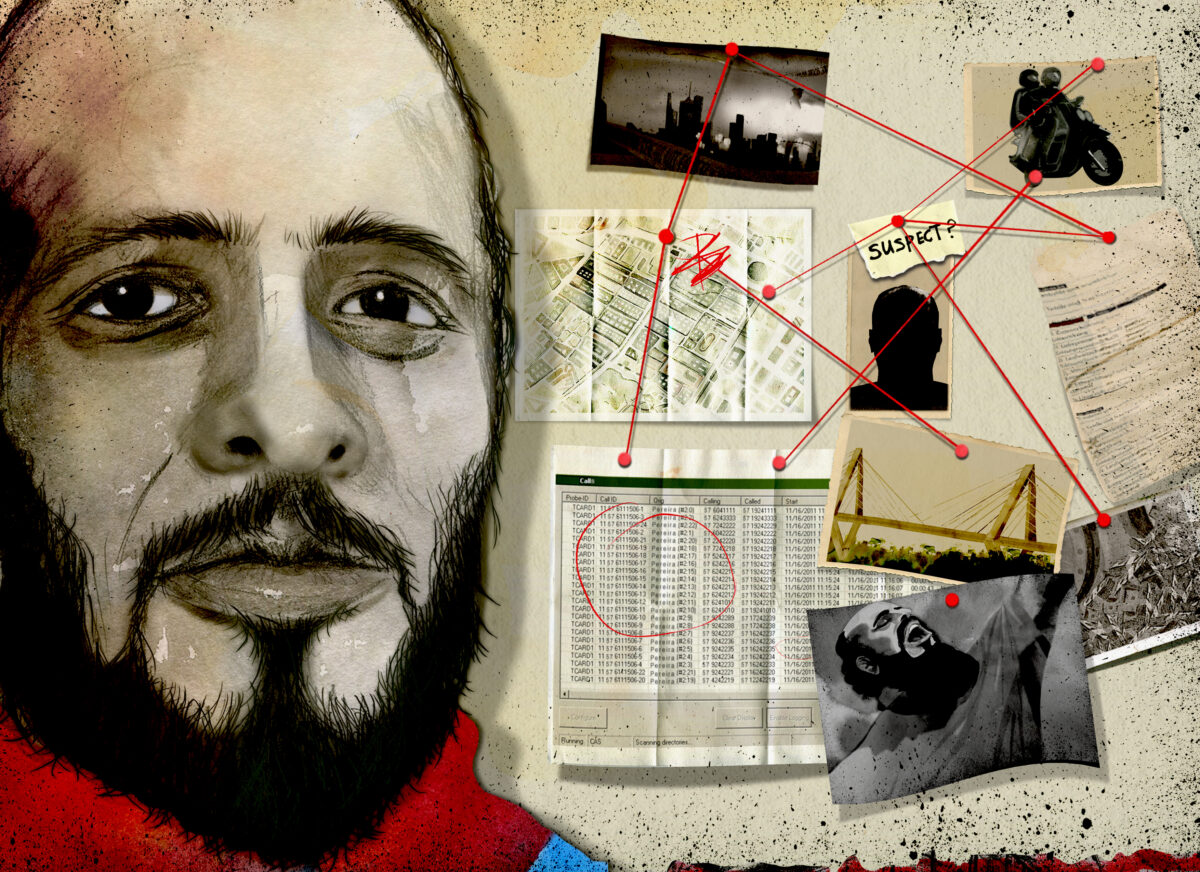Bogotá Car Bomb: What We Know
All times appear as local UTC-5.
On January 17, 2019, at 9:32 AM, an SUV loaded with 80 kilograms of pentolite exploded inside the Escuela de Cadetes de Policía “General Francisco de Paula Santander (General Francisco de Paula Santander Police Cadet School, ECSAN), the Colombian National Police academy located in southern Bogotá, killing 21 people and injuring 68 others. For the bombing, the authorities blamed Colombia’s “last active guerrilla” group: the Ejército de Liberación Nacional [National Liberation Army, ELN].
The blast evoked memories of the worst of the violence that shook Colombia through the last half of the 20th century, and threatens to trample the tenuous peace talks between the government and the ELN, the first attempts at which began in the 1990s. Aside from being the first bombing in the capital since June 2017, initial reports suggested that it was a suicide attack, a unprecedented guerrilla tactic in Colombia.
This article will provide an overview of the facts of the January 17 car bombing in Bogotá, as well as relevant background information. The analysis will consider the possibility that the bomber intended to strike a decoration ceremony that ended just minutes before the blast, and that he detonated the vehicle when he was unable to locate the ceremony.
Attack Preparations
Although the detonation of the bomb took place within the ECSAN, the preparation for this attack would have taken place long before. VBIEDs must be built, prepared and planned in detail before an effective attack takes place. Making sure all the correct equipment required to build a VBIED was in the right place at the right time is a logistical challenge, especially when one considers the fact that the security services in Colombia are still fighting against active militant groups like the ELN.
In this case, physical preparations appear to have begun on May 11 2018, when the Nissan Patrol used in the bombing was was purchased by José Aldemar Rojas Rodriguez, a.k.a “Mocho” or “Kiko,” in the Arauca department.
This is a timeline of vehicle use and ownership (source):
This vehicle would then have had to be transported from Arauca to Bogotá, a distance of several hundred kilometers. Colombian media reported that a police raid on a building located in southern Bogotá found evidence that the VBIED was loaded into the vehicle there. Using news reports of this building, it can be geolocated to a small alley on the Diagonal 75a Sur.
Geolocation of the workshop in Tejares de Usme (top: source, bottom: courtesy of Google/Digital Globe):
On the left, the site of the building as it appears on Google Street View with imagery from 2013. On the right, the site of the building as it appears today (source). The red rectangle marks a point of comparison:
The Route
The route of the VBIED to the detonation site was caught on several CCTV cameras, including some within ECSAN itself. We can therefore reconstruct the route the VBIED took to its target, including the last 5 kilometers which El Pais has already accurately reconstructed in detail:
Reconstruction of last 5 kilometers of the route:
The vehicle pulled over for 48 seconds next to a pedestrian bridge 450 meters to the west of the academy. There have been claims from Colombian media that at this point a single person left the vehicle. However, the video is very low quality, and skips 36 seconds prior to the person apparently exiting the vehicle.
Examination of CCTV footage indicates that there was in fact only a single person in the vehicle, as the sleeve of the driver is clearly visible from the right hand side, i.e. no one was blocking him in the passenger seat. The junction at which both of the below images were taken is only 260 meters away from where the vehicle stopped next to the pedestrian bridge.
Note that the front passenger seat of the vehicle appears to be empty (source):
The rear right passenger seat appears to have some kind of drum on it, likely containing a part of the explosive payload. Although it is difficult to be sure, it does not appear that anyone is sitting in the rear left seat, either.
What appears to be a drum marked in light blue. Note that in the image on the left there does not appear to be anyone sat in the back left of the vehicle. (left: source, right: source):
Although it does not appear that the Nissan had any passengers, it was tailed by a motorbike carrying two people over almost the entire route that El Pais reconstructed, bar the last 400 meters before the academy’s gate. It is not currently known who these two people were, or whether they were involved in the plot.
A collection of images showing the motorcycle trailing the vehicle. The first four images (top left, top right, bottom left) are from the El País route reconstruction (source). Bottom right: ~600 meters to the academy (source):
The Academy
The route within the academy is as follows:
According to Minister of Defense Guillermo Botero, the attack developed in the following way:
1 – The vehicle entered through a gate on the north side of the academy which is used “exclusively for transport vehicles.” The gate was already open “to let some motorcycles through,” and the Nissan sped through the gate. The guards were “immediately” aware of the incursion, and alerted other guards about it.
2 – The car approached the eastern gate of the camp. There, an officer who was apparently already aware of the breach approached the vehicle and interacted with the bomber. The vehicle then backed up, and drove away from the gate.
3 – The bomber drove a short distance north, made a left turn and detonated the VBIED in front of the women’s dormitory.
Geolocation of detonation. The yellow dot marks the point of detonation:
Contrary to initial reports, minister Botero denied that a bomb sniffing dog had detected the explosives in the truck, alerting the guards that an attack was imminent. According to the minister, the only bomb sniffing dog on campus was posted to the academy’s main gate, not the service gate through which the vehicle entered.
The explosion caused a large number of casualties: 21 dead and dozens more injured. The lack of catastrophic structural damage to nearby buildings indicates that the vehicle likely detonated near a group of people. As a training academy, this location would have had cadets marching in formation. Indeed, in one of the images released by the Colombian government, the vehicle can be seen passing several such squads near the entrance to the academy.
The vehicle drives by groups of cadets (source):
Hugo Kaaman, who has studied SVBIED’s extensively, has pointed out that if Rojas was simply aiming for a target of opportunity within the academy, he could have detonated next to one of these squads. Kaaman believes that Rojas was instead aiming for a graduation ceremony that was scheduled for that morning.
The official ECSAN Twitter account shared images and videos of this ceremony as it happened. The first tweet announcing the start of the ceremony was sent at 8:09 AM; the last, at 9:30 AM. The ceremony began earlier than scheduled due to the death of a cadet. Based on these tweets, we can locate the site of the ceremony to a road just north of the site of the detonation, some 140 meters away.
The site of the ceremony (blue), the route of the VBIED (red), the main northern gate (green) and the detonation (yellow circle):
Based on the ECSAN tweets, Rojas entered ECSAN at approximately the same time the ceremony was ending, indicating that this may have been the primary target. Given the route that Rojas took, including briefly stopping by the eastern gate and reversing, it seems he was disoriented and unsure of his target. We believe it is a possibility that Rojas was intending to enter ECSAN from the main northern gate (marked in green above), and proceed directly down the street into cadets assembled there for the ceremony. Instead, he turned right too early to enter the academy, became confused, missed the main ceremony, and then detonated next to a group of cadets.
The Bomber and the Accomplice
Colombian authorities provided their first substantive update on the bombing shortly before 8:00 AM on January 18. In a press conference, minister Botero claimed that Rojas had been a member of the ELN since at least 1994, and that he began working as an explosives expert for the group starting in 2003. Some time between 2008 and 2010, Rojas lost his right hand in an explosion.
Minister Botero also stated that since at least 2012, Rojas belonged to a faction of the ELN called Frente Domingo Lain [Domingo Lain Front], which operates in the Arauca department as part of the group’s Frente de Guerra Oriental [Eastern War Front] theater. There, the minister explained, Rojas worked in “direct” connection with the head of the Frente, a man named Luis Alberto Buritica (a.k.a Culebro Viejo), and then rose to “become responsible” for the Frente in 2013. Rojas was also identified as an “intelligence chief” by a former guerrilla member in 2017.
During the press conference, minister Botero revealed that Rojas was identified by a guard who interacted with him inside ECSAN approximately two minutes before the blast, and by fingerprint matching. A wiretap on an alleged ELN member named Ricardo Andres Carvajal Salgar captured a phone call he made at 10:13 AM — just 41 minutes after the bombing — ”recognizing” Rojas as the bomber and admitting to being involved in the attack.
Attorney general Néstor Humberto Martínez explained that the wiretap resulted in the execution of search warrants in Bogotá, and that Carvajal was arrested at 2:30 AM on January 18. Carvajal has been charged with aggravated terrorism, aggravated homicide, attempted homicide, causing damage to public property and aggravated transport of explosives. At the time of his arrest, Carvajal was found in the possession of overalls, a cell phone, and a book called “Manual del Combatiente ‘Primera Fase de Instrucción’” (“Combatant’s Manual: First Phase of Instruction”).
Images of the items found in Carvajal’s possession at the time of his arrest (source):
The ELN
The ELN formed in 1964 amid the violence that would mark Colombia’s fate for the rest of the century. Founded by a pair of priests, the ELN’s early membership was heavily influenced by Cuban revolutionary figures like Ernesto “Che” Guevara. In 2014, by the time the group and the Colombian government were attempting to re-start peace talks, the ELN was estimated to have had 2,500 soldiers.
For nearly three decades, the ELN and the Colombian government have unsuccessfully attempted to negotiate a lasting peace separate from the dialogue process involving the Fuerzas Armadas Revolucionarias de Colombia (Colombian Armed Revolutionary Forces, FARC). A recent effort began in February 2017, when representatives from both sides met in Quito, Ecuador.
In the hours following the bombing, Twitter suspended at least four ELN accounts: @ELN_Paz, @ELN_RANPAL_COL, @Urbano_ELN and @ELN_voces.
The Venezuelan Connection
Minister Botero also claimed that Rojas traveled to Venezuela in 2011 to “teach ELN members in that country and other people” how to handle explosives. Later in the same press conference, attorney general Martinez reiterated that there are ELN leaders in Venezuela, while another government official pointed out that Bogota asked Caracas last week to clarify whether three of the guerrilla’s leaders are currently in Venezuela.
This is not the first time that the ELN has been linked to Venezuela. On the contrary, the guerrilla’s presence in neighbouring Venezuela has received extensive attention not only in Colombian media, but also from international observers. The ELN made headlines in Venezuela as recently as November 4 of last year, after a group of guerrillas ambushed a Venezuelan National Guard patrol in Amazonas state, killing at least three soldiers and injuring another ten.
The ELN executed that attack, local media reported, after Venezuelan authorities arrested a guerrilla leader named Luis Felipe Ortega Bernal (a.k.a. “Garganta”) and four of his fighters inside Venezuela. Media reports named Bernal as a member of the ELN’s faction, the same one to which Rojas allegedly belonged.
Analysis
The ELN claimed responsibility for the attack in a statement posted on its website on January 21, and called the bombing “lawful.”
There has been debate over whether this attack was intended as a suicide VBIED, or whether it was a VBIED which went wrong. On the one hand, Rojas was an experienced bomb-maker, which is a significant asset to any militant group. He would have likely been a better asset to the ELN continuing to make bombs. It also appears the operation went awry in the last seconds, as Rojas was almost caught by a guard at the eastern gate. It could be that Rojas intended to plant the bomb and then attempt to escape, but detonated the bomb using an emergency initiator in desperation.
However, the fact that Rojas was driving the vehicle is in itself unusual: Using a bomb-maker to plant a bomb is a high-risk strategy. Rojas’ method for entering the academy itself was very high-risk, and there appears to have been little prospect for Rojas to escape arrest if he did intend to abandon the vehicle. With the current open-source information available it seems that this attack was a genuine SVBIED rather than a VBIED that went wrong. If so, this would make it an unprecedented event in Colombia to our knowledge.
In a January 18 statement, Colombian president Ivan Duque said that he had ordered an end to the moratorium on arrest warrants against ELN members, a clear sign that Bogota is once again on the offensive against the group.
This article was co-authored with Nick Waters.
